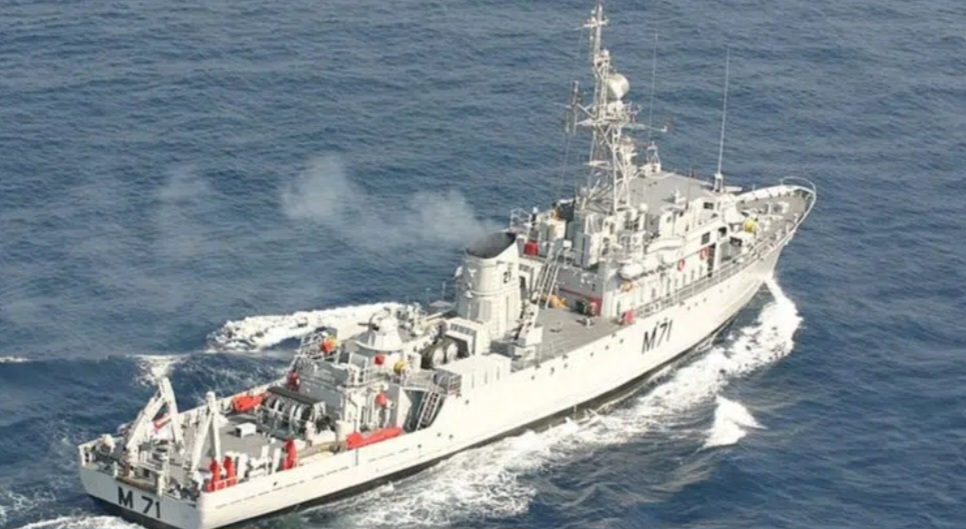By: Rahul Wankhede

Focusing on India’s evolving naval capabilities and priorities, this article highlights the importance of Mine Counter Measure Vessels (MCMVs) in the context of India’s maritime security. This article takes an overview of the MCMV acquisition process in the Indian Navy and presents an analysis of the attempts made by the navy to procure these vessels. It also emphasizes on the need to rationalize priorities and resources to achieve strategic objectives, without compromising on the quantity and quality of the naval fleet. It discusses the challenges faced in procuring MCMVs, the need for a balanced approach in naval modernization plans, and the implications of the absence of dedicated mine-warfare capabilities in the face of emerging tensions in the Indian Ocean region.
Introduction
Over the last few years India’s military naval fleet has seen a constant growth with the addition of new vessels like: frigates, destroyers, corvettes and even a full-fledged aircraft carrier that was built indigenously. Amongst the three-armed forces, it’s the Indian Navy that has been spear-heading the call for self-reliance in the defence sector, by in-house designing, building and acquisition of ships and other vessels.
Notwithstanding this appreciable growth and acquisitions is the glaring anomaly of absence of minesweepers in the Indian Navy. Technically called as MCMV – Mine Counter Measures Vessels, these ships perform the important function of locating and destroying enemy mines under-water. An under-water mine is a silent killer, as it silently floats under-water, waiting for a ship to pass by and it explodes after contact is established.
In a shocking revelation, it has recently come to public attention that the Indian Navy does not have a single minesweeper vessel since 2021.
Indian Navy’s Absent MCMV Fleet
India has a total of 13 major ports on its eastern and western seaboards. At the rate of 2 MCMVs per port, the Indian Navy needs at least 26 such vessels. Apart from these, there are various other small ports, docks and other important assets along the coastline that need to be protected. Sea going vessels also either need to be accompanied by a MCMV or fitted with mine-detecting equipment. But no new MCMV has been inducted in the navy’s service since 1998.
Earlier the Indian Navy operated a fleet of Pondicherry class MCMVs: INS Pondicherry, INS Bedi, INS Bhavnagar, INS Alleppey and INS Ratnagiri that were deployed under the Western Naval Command. These entered service during 1978-80 and were retired by 2007-2015.
The Karwar class MCMVs, namely: INS Karwar, INS Kunnor, INS Kuddulor, INS Kakinada, INS Kozhikode and INS Konkan were deployed under the Eastern Naval Command at Vishakhapatnam. These were inducted during 1986-88 and were retired by 2017-19.
The UPA government had tried to procure MCMVs, around 15 years ago, but the project was abandoned after the lowest bidder – Kanganam Corporation, a South Korean company was accused of wrongdoings.
The government scrapped the tender in 2014 amid allegations that the Korean firm had hired middlemen to swing things in its favour, thus violating the integrity clause.
As of 2015, India was left with just six MCMVs as against the requirement of 26. The Centre finally nominated Goa Shipyard Limited (GSL) in February 2015 to build minesweepers in partnership with a foreign shipyard.
This time also, Kanganam had emerged as the lowest bidder. It was later clarified that the previous tender was scrapped due to “procedural issues” and Kangnam could compete again as it was not on the government’s blacklist. The deal was supposed to be closed the same year but discussions on technology transfer caused delays, and eventually the contract was finally scrapped in 2018.
The Defence Standing Committee is known to have requested that “sincere and concerted efforts” be made by the government to provide the navy with the essential MCMV capacity in its 2017 report, which was presented to the Parliament. The report also mentioned “the existing MCMVs are slated for de-induction by 2016-2018. 2016 has already passed and moreover, building the MCMVs will also take considerable time. The Committee feels that the entire process of procurement of MCMVs will be delayed inordinately”.
Therefore, as of 2018 the Indian Navy was left with just two operational MCMVs. In fact, the navy lacks any MCM vessels, let alone modern counter-mine naval platforms.
Failing to procure new MCMVs through all the above attempts, in August 2021, the Ministry of Defence (MoD) issued a Request for Information (RFI) for four used MCMVs hoping to get them on lease from a foreign government for the Indian Navy. “The government required three to four such units to be procured or leased, whose first vessel was supposed to be delivered in a maximum 10 months delay. The others were to follow by delivery every 4 months”. This proposal as well, did not go through.
The Indian Navy has now launched a fresh hunt to buy 12 new MCMVs from Indian shipyards to strengthen its mine-warfare capabilities, as per a report by Hindustan Times. These minesweepers capable of finding, destroying and laying mines, would be constructed over a period of eight years according to a RFI published by the MoD. The order will be divided between L1 (lowest bidder) and L2 shipyards in an 8:4 ratio, with L2 shipyards being obligated to build the ships at L1 cost. The roles that the vessels should be able to carry out are listed in the RFI. This plan involves the induction of twelve minesweepers, the first one being delivered by 2031 and the last one being delivered by around 2037.
It can thus be assessed that at present, India does not have the required capability to scour its harbours for potential mines and explosives for at least eight years, making them highly vulnerable to enemy action
Though alternative technologies like unmanned underwater vehicles have recently emerged on the technological spectrum, no viable alternative that can totally replace the need for a MCMV has yet been developed anywhere in the world
Importance of MCMVs for India’s Maritime Security
Considering India’s interests in the vast Indian Ocean Region, there is a constant threat of underwater mines being planted by Pakistan and/or China to deter Indian advancements in the region. It is now well known that the Chinese submarines regularly patrol the Indian Ocean – and could possibly deploy mines. Also, even modified fishing trawlers can be used for laying mines, multiplying the threat at the sub-conventional level, for India.
It is therefore high time that India devotes the necessary funds and resources from its defence budget towards acquiring more MCMVs and their related infrastructure and assets. While doing so, India may have to divert resources from its other ambitious programs to acquire a third aircraft carrier (a big-ticket item), ships, submarines etc. India does need more of these assets as well, but not at the cost of other key strike elements, force multipliers and support vessels.
India also needs to spend on other less glamorous but critical weapons platforms such as minesweepers, autonomous torpedoes, coastal surveillance radars, electronic warfare suites, reconnaissance drones and satellites etc. India can draw some lessons from China’s shipbuilding plan to stimulate the domestic economy rather than trying to compete “carrier for carrier” with China. Shipbuilding has served as the foundation for China’s industrial development, according to state policy established long ago by China’s political and military leadership. Since India is surrounded by countries to its north and northeast and has no other strategic space to move than the oceans, this can be very helpful India.
The Indian Navy needs to procure more than 26 units of MCMVs to fulfil its immediate requirements. This will have to be complemented by follow-on orders to achieve economies-of-scale and to keep the production lines active. Once the navy has the desired number of vessels, India can also look forward to build new MCMVs for exports. This would serve as a hallmark to the product quality and operational efficiency. Therefore, what is now needed on the government’s part is to take a bird’s eye view of the situation, ensure sufficient resources and prioritise its acquisition process by fully leveraging the available capabilities.
Conclusion
The absence of Mine Counter Measures Vessels (MCMVs) in the Indian Navy’s fleet is a significant and concerning aspect of India’s naval capabilities. Despite the notable growth and advancements in various naval domains, the omission of minesweepers, crucial for locating and neutralizing underwater mines, presents a glaring vulnerability.
This is not a welcome proposition for a country that wishes its Navy to be a blue-water force.
In light of the above challenges, it becomes imperative for the Indian Navy and the government to prioritize the acquisition lists, fund allocations and support the development of in-house solutions. Existing programs need to be continued rather than winding them up abruptly.
Addressing these gaps will not only enhance India’s defence capabilities but also contribute to the safeguarding of vital sea routes, maritime interests, and overall national security in the dynamic and complex maritime security environment of India.

About the Author
Rahul Wankhede is a post graduate in Defence and Strategic Studies with a gold medal. Rahul has worked with think tanks and NGOs in the domains of research, analysis and mentoring and is a former Assistant Professor in the Department of Defence and Strategic Studies, Savitribai Phule Pune University, Pune, India. Currently he is doing PhD from JNU Special Centre for National Security Studies. The views expressed are personal.

